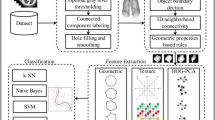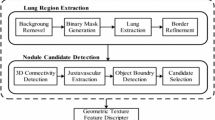Abstract
Lung cancer is a deadly disease if not diagnosed in its early stages. However, early detection of lung cancer is a challenging task due to the shape and size of its nodules. Radiologists use automated tools for more precise opinion. Automated detection of the affected lung nodules is complicated because of the shape similarity among healthy and unhealthy tissues. Over the years, several expert systems have been developed that help radiologists to diagnose lung cancer effectively. In this article, we have proposed a framework to precisely detect lungs cancer to classify the benign and malignant nodules. The proposed framework is tested using the subset of the publicly available dataset, i.e., the Lung Image Database Consortium image collection (LIDC-IDRI). We applied filtering and noise removal in the pre-processing phase. Furthermore, the adaptive thresholding technique (OTSU) and the semantic segmentation are used to accurately detect the unhealthy lung nodules. Overall, 13 nodules features have extracted using principal components analysis algorithm. In addition, four optimal features are selected based on the classification performance. In the classification phase, 9 different classifiers are employed for the experimentation. Empirical analysis shows that the proposed system outperformed other techniques and provides 99.23% accuracy using a logit boost classifier.














Similar content being viewed by others
References
Akram S, Javed MY, Qamar U, Khanum A, Hassan A (2015) Artificial neural network based classification of lungs nodule using hybrid features from computerized tomographic images. Appl Math Inf Sci 9(1):183
Akram S, Javed MY, Akram MU, Qamar U, Hassan A (2016) Pulmonary nodules detection and classification using hybrid features from computerized tomographic images. J Med Imaging Health Inform 6(1):252–259
Bankier AA, MacMahon H, Goo JM, Rubin GD, Schaefer-Prokop CM, Naidich DP (2017) Recommendations for measuring pulmonary nodules at CT: a statement from the Fleischner society. Radiology 285(2):584–600
Chen S, Yao L, Chen B (2016) A parameterized logarithmic image processing method with Laplacian of Gaussian filtering for lung nodule enhancement in chest radiographs. Med Biol Eng Comput 54(11):1793–1806
de Carvalho Filho AO, Silva AC, de Paiva AC, Nunes RA, Gattass M (2017) Lung-nodule classification based on computed tomography using taxonomic diversity indexes and an SVM. J Signal Process Syst 87(2):179–196
Demir Ö, Yılmaz Çamurcu A (2015) Computer-aided detection of lung nodules using outer surface features. Biomed Mater Eng 26(s1):S1213–S1222
Dietterich TG (2000) An experimental comparison of three methods for constructing ensembles of decision trees: bagging, boosting, and randomization. Mach Learn 40(2):139–157
El-Regaily SA, Salem MAM, Aziz MHA, Roushdy MI (2017) Lung nodule segmentation and detection in computed tomography. In: 2017 Eighth international conference on intelligent computing and information systems (ICICIS). IEEE, pp 72–78
El-Regaily SA, Salem MA, Abdel Aziz MH, Roushdy MI (2018) Survey of computer aided detection systems for lung cancer in computed tomography. Curr Med Imaging Rev 14(1):3–18
Elsayed O, Mahar K, Kholief M, Khater HA (2015) Automatic detection of the pulmonary nodules from ct images. In: SAI intelligent systems conference (IntelliSys), 2015. IEEE, pp 742–746
Foody GM, Mathur A (2004) A relative evaluation of multiclass image classification by support vector machines. IEEE Trans Geosci Remote Sens 42(6):1335–1343
Froz BR, de Carvalho Filho AO, Silva AC, de Paiva AC, Nunes RA, Gattass M (2017) Lung nodule classification using artificial crawlers, directional texture and support vector machine. Expert Syst Appl 69:176–188
Hancock MC, Magnan JF (2017) Predictive capabilities of statistical learning methods for lung nodule malignancy classification using diagnostic image features: an investigation using the lung image database consortium dataset. In: Medical imaging 2017: computer-aided diagnosis, vol 10134. International Society for Optics and Photonics, p 1013425
Hoo-Chang S, Roth HR, Gao M, Lu L, Xu Z, Nogues I, Yao J, Mollura D, Summers RM (2016) Deep convolutional neural networks for computer-aided detection: CNN architectures, dataset characteristics and transfer learning. IEEE Trans Med Imaging 35(5):1285
Huang X, Shan J, Vaidya V (2017) Lung nodule detection in CT using 3d convolutional neural networks. In: 2017 IEEE 14th international symposium on biomedical imaging (ISBI 2017). IEEE, pp 379–383
Hussain MA, Ansari TM, Gawas PS, Chowdhury NN (2015) Lung cancer detection using artificial neural network & fuzzy clustering. Int J Adv Res Comput Commun Eng. https://doi.org/10.17148/IJARCCE.2015.4386
Jaffar MA, Zia MS, Hussain M, Siddiqui AB, Akram S, Jamil U (2018) An ensemble shape gradient features descriptor based nodule detection paradigm: a novel model to augment complex diagnostic decisions assistance. Multimed Tools Appl 27:1–27
Javaid M, Javid M, Rehman MZU, Shah SIA (2016) A novel approach to CAD system for the detection of lung nodules in CT images. Comput Methods Progr Biomed 135:125–139
Krishnamurthy S, Narasimhan G, Rengasamy U (2016) Three-dimensional lung nodule segmentation and shape variance analysis to detect lung cancer with reduced false positives. Proc Inst Mech Eng Part H J Eng Med 230(1):58–70
Li W, Cao P, Zhao D, Wang J (2016) Pulmonary nodule classification with deep convolutional neural networks on computed tomography images. Comput Math Methods Medicine
Lu L, Tan Y, Schwartz LH, Zhao B (2015) Hybrid detection of lung nodules on CT scan images. Med Phys 42(9):5042–5054
Mathew ST, Nachamai M (2016) Methodical in methodical investigation of filtering algorithms for human brain MRI. Int J Control Theory Appl
Parvin H, MirnabiBaboli M, Alinejad-Rokny H (2015) Proposing a classifier ensemble framework based on classifier selection and decision tree. Eng Appl Artif Intell 37:34–42
Ramírez J, Górriz JM, Ortiz A, Padilla P, Martínez-Murcia FJ, Alzheimer Disease Neuroimaging Initiative (2016) Ensemble tree learning techniques for magnetic resonance image analysis. In: Innovation in medicine and healthcare 2015. Springer, Cham, pp 395–404
Setio AA, Jacobs C, Gelderblom J, Ginneken B (2015) Automatic detection of large pulmonary solid nodules in thoracic CT images. Med Phys 42(10):5642–5653
Shaukat F, Raja G, Gooya A, Frangi AF (2017) Fully automatic detection of lung nodules in CT images using a hybrid feature set. Med Phys 44(7):3615–3629
Shaukat F, Raja G, Ashraf R, Khalid S, Ahmad M, Ali A (2019) Artificial neural network based classification of lung nodules in CT images using intensity, shape and texture features. J Ambient Intell Humaniz Comput 10:1–15
Shen S, Bui AA, Cong J, Hsu W (2015) An automated lung segmentation approach using bidirectional chain codes to improve nodule detection accuracy. Comput Biol Med 57:139–149
Siegel RL, Miller KD, Jemal A (2019) Cancer statistics, 2019. CA Cancer J Clin 69(1):7–34
Teramoto A, Fujita H, Yamamuro O, Tamaki T (2016) Automated detection of pulmonary nodules in PET/CT images: ensemble false-positive reduction using a convolutional neural network technique. Med Phys 43(6Part1):2821–2827
Tran GS, Nghiem TP, Nguyen VT, Luong CM, Burie JC (2019) Improving accuracy of lung nodule classification using deep learning with focal loss. J Healthc Eng. https://doi.org/10.1155/2019/5156416
Valente IRS, Cortez PC, Neto EC, Soares JM, de Albuquerque VHC, Tavares JMR (2016) Automatic 3d pulmonary nodule detection in CT images: a survey. Comput Methods Progr Biomed 124:91–107
World Health Organization (2019) Cancer fact sheet. https://www.who.int/en/news-room/fact-sheets/detail/cancer
Yuan J, Liu X, Hou F, Qin H, Hao A (2018) Hybrid-feature-guided lung nodule type classification on CT images. Comput Graph 70:288–299
Author information
Authors and Affiliations
Corresponding author
Ethics declarations
Conflict of interest
The authors declare that they have no conflict of interest.
Ethical approval
This article does not contain any studies with human participants or animals performed by any of the authors.
Informed consent
Informed consent was obtained from all individual participants included in the study.
Additional information
Publisher's Note
Springer Nature remains neutral with regard to jurisdictional claims in published maps and institutional affiliations.
Rights and permissions
About this article
Cite this article
Meraj, T., Rauf, H.T., Zahoor, S. et al. Lung nodules detection using semantic segmentation and classification with optimal features. Neural Comput & Applic 33, 10737–10750 (2021). https://doi.org/10.1007/s00521-020-04870-2
Received:
Accepted:
Published:
Issue Date:
DOI: https://doi.org/10.1007/s00521-020-04870-2




